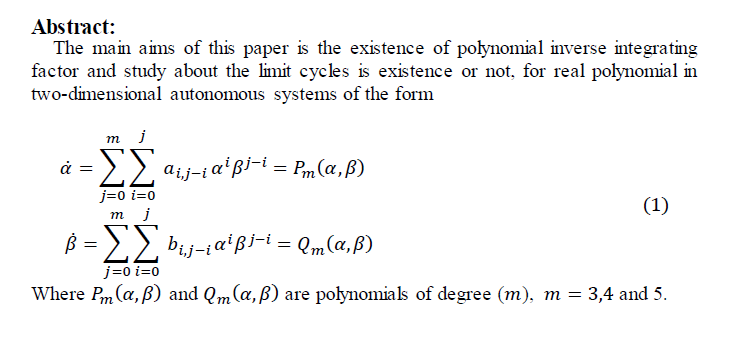The present study is concerned with the writer's ideologies towards violence against women. The study focuses on analyzing violence against women in English novel to see the extent the writers are being affected and influenced by their genders. It also focuses on showing to what extent the writer's ideologies are reflected in their works. Gender influences social groups ideologies; therefore, when a writer discusses an issue that concerns the other gender, they will be either subjective or objective depending on the degree of influence, i.e., gender has influenced their thoughts as well as behaviors. A single fact may be presented differently by different writers depending on the range of a
... Show MoreGeomorphology is concerned with the topographic units that make up the Earth's surface. These take many forms, such as mountains and rivers, and include many dangers such as landslides, landslides and erosion. Many studies appeared in this field to analyze its effects and risks resulting from it, including urban studies, to determine the trends of optimal urban expansion and its geomorphological interactions. The results showed that the city of Kut originated and expanded near the course of the Tigris River and its branches, and it suffers from unbalanced urban expansion, due to the high rate of population growth, and overcrowding in housing units with the growth of urban land uses in it, which prompted the city to extend horizontally and v
... Show MoreA design for a photovoltaic-thermal (PVT) assembly with a water-cooled heat sink was planned, constructed, and experimentally evaluated in the climatic conditions of the southern region of Iraq during the summertime. The water-cooled heat sink was applied to thermally manage the PV cells, in order to boost the electrical output of the PVT system. A set of temperature sensors was installed to monitor the water intake, exit, and cell temperatures. The climatic parameters including the wind velocity, atmospheric pressure, and solar irradiation were also monitored on a daily basis. The effects of solar irradiation on the average PV temperature, electrical power, and overall electrical-thermal efficiency were investigated. The findings i
... Show More (31)
(31)
 (29)
(29)
This research aims to study the methods of reduction of dimensions that overcome the problem curse of dimensionality when traditional methods fail to provide a good estimation of the parameters So this problem must be dealt with directly . Two methods were used to solve the problem of high dimensional data, The first method is the non-classical method Slice inverse regression ( SIR ) method and the proposed weight standard Sir (WSIR) method and principal components (PCA) which is the general method used in reducing dimensions, (SIR ) and (PCA) is based on the work of linear combinations of a subset of the original explanatory variables, which may suffer from the problem of heterogeneity and the problem of linear
... Show MoreThe purpose of this paper is to apply different transportation models in their minimum and maximum values by finding starting basic feasible solution and finding the optimal solution. The requirements of transportation models were presented with one of their applications in the case of minimizing the objective function, which was conducted by the researcher as real data, which took place one month in 2015, in one of the poultry farms for the production of eggs
... Show MoreThe study aimed to reveal the level to which the international issues are integrated into the books of Saudi public education social studies and citizenship in the light of the principles of international education, and to know the level of continuity and integration of these issues in the books, to build a range and sequence matrix of international issues through it. The study followed the descriptive and analytical method that used the content analysis card as a tool for study when the tool achieved the necessary validity and reliability characteristics. The data of this study has been processed using the SPSS statistical program according to a set of appropriate methods of descriptive and inferential statistics.
The resu
... Show More (10)
(10)
 (11)
(11)
Abstract
The research seeks to shed light on green accounting information systems, analyze them, identify sustainability reporting and how to improve it, as well as study the importance of the Iraqi oil sector, analyze it, and work on applying green accounting information systems in order to improve the quality of sustainability reporting. Oil as a branch of the General Corporation for the Distribution of Oil and Gas Products to apply the practical aspect and prove the hypothesis of the research. Explaining the company's role in improving environmental conditions
In this study, successive electrocoagulation (EC) and electro-oxidation (EO) processes were used to minimize some of the major pollutants in real wastewater, such as organics (detected by chemical oxygen demand (COD)), and turbidity. The wastewater utilized in the present study was collected from the Midland Refinery Company in Baghdad-Iraq. The performance of the successive batch EC-EO processes was studied by utilizing Graphite and Aluminum (Al) as monopolar anode electrodes and stainless steel (st.st.) as the cathode. The Taguchi experimental design approach was used to attain the best experimental conditions for COD reduction as a major response. Starting from chemical oxygen demand COD of (600 ppm), the effects of current density (C
... Show More (20)
(20)
In this study, successive electrocoagulation (EC) and electro-oxidation (EO) processes were used to minimize some of the major pollutants in real wastewater, such as organics (detected by chemical oxygen demand (COD)), and turbidity. The wastewater utilized in the present study was collected from the Midland Refinery Company in Baghdad-Iraq. The performance of the successive batch EC-EO processes was studied by utilizing Graphite and Aluminum (Al) as monopolar anode electrodes and stainless steel (st.st.) as the cathode. The Taguchi experimental design approach was used to attain the best experimental conditions for COD reduction as a major response. Starting from chemical oxygen demand COD of (600 ppm), the effects of current densi
... Show More (20)
(20)

